
职 称:
教授
通信地址:
广州市白云区沙太南路1023号-1063号南方医科大学公共卫生学院毒理学系
Email:
zhzliang@smu.edu.cn
职 务:
系副主任
职称级别:
正高
学术任职:
1. 广东省毒理学会理事
2. 中国毒理学会表观遗传毒理专业委员会委员;
3. 中国环境诱变剂学会致突变专业委员会委员;
4. 中国生物物理学会光生物物理专业委员会委员;
5. 第五届广州市突发公共卫生事件应急专家委员会核与辐射事件处置专家组成员;
最高学历:
博士
所属科室:
毒理学系
研究方向:
细胞应激的分子毒理学机制,包括药化毒理学、放射毒理学和肿瘤分子毒理等领域,主要研究在化学、物理因素诱导细胞应激条件下,正常皮肤或皮肤肿瘤细胞中非编码RNA(LncRNA和miRNA)和表观遗传调控因子在细胞凋亡、自噬、内质网应激、低氧应激、糖代谢和EMT等进程中的分子毒理学作用机制,重点关注LncRNA介导的关键节点蛋白修饰的变化对重要信号传导通路和细胞命运的影响。研究方向:
LncRNA介导的蛋白修饰在应激条件下影响肿瘤细胞命运中的调控机理;
1. 化学物(药物)引起细胞损伤和致癌的信号传导和表观遗传调控机理;
2. 电离辐射所致细胞应激的分子毒理学机制。
科研项目:
1. 2017年国家自然科学基金面上项目“HOXA9调控HIF-1α及其下游糖酵解代谢在皮肤鳞癌发生发展中的功能与机制研究”;
2. 2021年广东省自然科学基金面上项目“LINP1调控CHOP介导的细胞凋亡促进皮肤鳞癌进展的机制研究”;
3. 2019年广东省自然科学基金面上项目“LINC01021促进黑色素瘤电离辐射抗性的机理研究”;
4. 2019年广州市科技计划一般项目“Sirtuin家族介导黑色素瘤放疗辐射抗性的筛选与分子机制研究”;
5. 2016年广东省自然科学基金面上项目“miR-365靶基因HOXA9调控皮肤鳞状细胞癌自噬与凋亡的分子机制研究”。
成果奖励:
专利/Patents:
1. 周良,丁振华,张颖,郝帅,关于工频电磁辐射的微小RNA剂量标志物,2019.11.01,中国,ZL201610856753.1;
2. 丁振华,周良,郝帅,张颖,关于工频电磁辐射的趋化因子剂量标志物,2019.02.12,中国,ZL201610855233.9;
3. 丁振华,周良,高琳,李姗姗,靶向KTN1治疗皮肤鳞状细胞癌的药物,2019.04.23,中国,ZL201710093598.7。
4. 丁振华,周良,王颖慧,王鹏飞,HOXA9基因在制备治疗皮肤鳞状细胞癌药物中的应用,2021.05.04, 中国,ZL201710551188.2。
代表论文:
1. Zhou L,Wang Y, Zhou M, Zhang Y, Wang P, Li X, Yang J, Wang H, Ding Z*. HOXA9 Inhibits HIF-1α-Mediated Glycolysis through Interacting with CRIP2 to Repress Cutaneous Squamous Cell Carcinoma Development. Nature Communications. 2018. 9(1):1480.
2. Zhou L, Sun K, Zhao Y, Zhang S, Wang X, Li Y, Lu L, Chen X, Chen F, Bao X, Zhu X, Wang L, Tang L, Esteban MA, Wang CC, Jauch R, Sun H*, Wang H*. Linc-YY1 promotes myogenic differentiation and muscle regeneration through an interaction with the transcription factor YY1. Nature Communications. 2015. 6:10026.
3. Han S, Li X, Wang K, Zhu DH#, Meng BY, Liu JY, Liang XT, Jin Y, Liu XY, Wen Q*, Zhou L*. PURPL represses autophagic cell death to promote cutaneous melanoma by modulating ULK1 phosphorylation. Cell Death & Disease, 2021; 12(11):1070.
4. Zhang Y, Gao L, Ma S, Ma J, Wang Y, Li S, Hu X, Han S, Zhou M, Zhou L*, Ding Z*. MALAT1-KTN1-EGFR regulatory axis promotes the development of cutaneous squamous cell carcinoma. Cell Death & Differentiation. 2019. 26(10):2061-2073.
5. Han S, Li X, Liang X, Zhou L*. HOXA9 Transcriptionally Promotes Apoptosis and Represses Autophagy by Targeting NF-κB in Cutaneous Squamous Cell Carcinoma. Cells. 2019. 8(11). pii: E1360.
6. Zhou L, Gao R, Wang Y, Zhou M, Ding Z*. Loss of BAX by miR-365 Promotes Cutaneous Squamous Cell Carcinoma Progression by Suppressing Apoptosis. International Journal of Molecular Sciences. 2017. 18(6): 1157.
7. Zhou L, Wang Y, Ou C, Lin Z, Wang J, Liu H, Zhou M, Ding Z*. microRNA-365-targeted nuclear factor I/B transcriptionally represses cyclin-dependent kinase 6 and 4 to inhibit the progression of cutaneous squamous cell carcinoma. International Journal of Biochemistry & Cell Biology. 2015. 65:182-191.
8. Zhou L, Wang LJ, Lu LN, Jiang PY, Sun Hao*, Wang HT*. A novel target of microRNA-29, Ring1 and YY1-binding protein (Rybp), negatively regulates skeletal myogenesis. Journal of Biological Chemistry. 2012;287(30):25255-25265.
9. Zhou L, Wang LJ, Lu LN, Jiang PY, Sun Hao*, Wang HT*. Inhibition of miR-29 by TGF-beta-Smad3 signaling through dual mechanisms promotes transdifferentiation of mouse myoblasts into myofibroblasts. PLoS One. 2012;7(3):e33766.
10. Li MW#, Zhou L#, Lam HM*. Paraformaldehyde Fixation May Lead to Misinterpretation of the Subcellular Localization of Plant High Mobility Group Box Proteins. PLoS One. 2015;10(8):e0135033.
11. Zhou L, Cheung MY, Li MW, Fu YP, Sun ZX, Sun SS, Lam HM*. Rice hypersensitive induced reaction protein 1 (OsHIR1) associates with plasma membrane and triggers hypersensitive cell death. BMC Plant Biology. 2010;10:290.
12. Zhou L, Cheung MY, Zhang Q, Lei CL, Zhang SH, Sun SS, Lam HM*. A novel simple extracellular leucine-rich repeat (eLRR) domain protein from rice (OsLRR1) enters the endosomal pathway and interacts with the hypersensitive-induced reaction protein 1 (OsHIR1). Plant, Cell & Environment. 2009;32(12):1804-1820.
教育背景:
1993/09——1997/07,汉中师范学院,生物教育专业,获学士学位;
1997/09——2000/06,四川大学,动物学专业,获硕士学位;
2005/07——2009/09,香港中文大学,生物学专业,获博士学位;
工作经历:
2000/07——2004/08,成都华神生物技术有限责任公司质量部;
2004/09——2005/07,深圳国家生化工程技术开发中心研发部;
2009/09——2011/08,香港中文大学医学院,研究助理;
2011/09——2013/03,香港中文大学医学院,博士后;
2013/03——2019/07,南方医科大学公共卫生学院放射医学系,副教授;
2019/07——2022/01,南方医科大学公共卫生学院毒理学系,副教授;
2022/01至今,南方医科大学公共卫生学院毒理学系,教授。